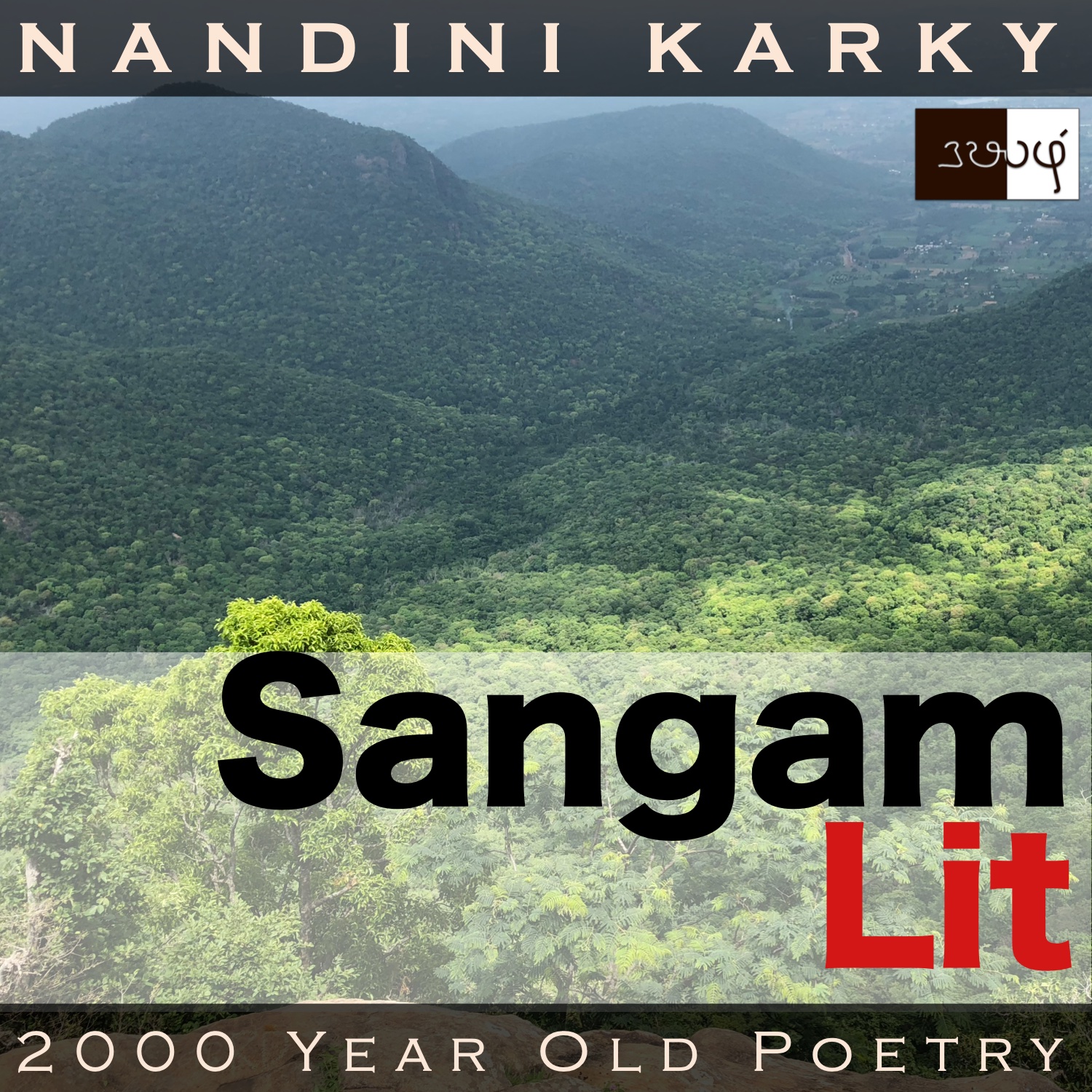Podcast: Play in new window | Download
Subscribe: Apple Podcasts | Spotify | Amazon Music | Android | iHeartRadio | Email | TuneIn | RSS | More

In this episode, we perceive a technique to bear with parting, as depicted in Sangam Literary work, Kurunthogai 249, penned by Kabilar. The verse is situated in the hills of ‘Kurinji’ and speaks in the voice of the lady to the confidante, in response to the question as to how the lady would handle the man’s separation.
இன மயில் அகவும் மரம் பயில் கானத்து,
நரை முக ஊகம் பார்ப்பொடு பனிப்ப,
படு மழை பொழிந்த சாரல் அவர் நாட்டுக்
குன்றம் நோக்கினென்-தோழி!-
பண்டையற்றோ, கண்டிசின், நுதலே?
‘His hill will do’ says this verse! The opening words ‘இன மயில் அகவும்’ meaning ‘a group of peacocks call out aloud’, instantly transport us to an ancient jungle, whose skies are turning silver, readying to rain upon the land. In ‘நரை முக ஊகம்’ meaning ‘a monkey with a grey face’, I learnt a new word ‘ஊகம்’ for ‘a monkey’. This description corresponds accurately with a ‘Grey langur’, a monkey you cannot miss in the Indian subcontinent, with its shining black face, surrounded by a frame of white fur. I relished that the word used to describe this monkey’s white fur is ‘நரை’, which is the contemporary Tamil word for ‘grey hair’, an unmistakable sign of age and shall I say, wisdom? Moving on, we glimpse at ‘படு மழை பொழிந்த சாரல்’ meaning ‘the slopes where heavy rain has fallen’. The central thought of this verse echoes in ‘குன்றம் நோக்கினென்’ meaning ‘I looked at the hill’. Ending with the words ‘பண்டையற்றோ கண்டிசின் நுதலே’ meaning ‘can you see that my forehead is as it was before?’ the verse welcomes us to explore more.
The vision of a hill seems to have a striking effect on someone! The context reveals that the man and lady were leading a love relationship when the man decided to part with the lady to gather wealth for their wedding. Learning of the man’s decision, the confidante approaches the lady to ask how she was going to bear with the man’s separation. To the confidante, the lady says, “A flock of peafowls call out aloud in the tree-filled jungle and a grey-faced monkey and its little ones shiver as heavy rains pour in the mountain slopes of his domain. Don’t you see my forehead has attained its old beauty after I gazed at that hill of his?” With these words, the lady conveys to her confidante that she has found a way to handle the man’s absence.
What could the lady mean? From where arises her conviction? Let’s explore by following her words closely. The lady starts by taking us to a lush forest, from where a muster of peacocks call out aloud. From the birds, the lady shifts her focus to those grey-faced monkeys cuddling their infants and shivering together. To explain the reason for the shivering, the lady informs us that heavy rains have been pelting those slopes. All this turns out to be the description of the man’s land. In this generic description, the lady zooms on to a specific feature, a hill that decks that domain and remarks that she has looked at it, and asks whether the confidante notices how her forehead looks as it always used to.
To understand what the lady exactly means, we have to recollect that a Sangam lady’s forehead was the first marker of her beauty and health. Any time, she was pining, the glow is said to fade away from this part of her face. And so, when she remarks that her forehead was as it was, she means that signs of pining and ill-health have disappeared and she has regained her celebrated beauty. And, how did this happen? Just because she glanced at the peak that belongs to the man’s land! In that element of the land, the lady sees the promise of her love and finds the strength to go on, even in the man’s absence. The question is the same in verse after verse in Sangam Literature – ‘How will you face it’ and yet, new answers keep coming. So many ways to see a situation, these verses say! In its tiny shell, the verse holds a key to handle grief and loss. Like this lady from the past shows us, even today, in a memory left behind, an object used, a path traversed together, a laughter shared, the people we miss can surely be found!




Share your thoughts...